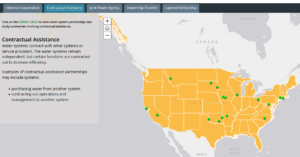Drinking Water System Partnerships Case Study Map Tool Available on EPA’s Website
 EPA developed an interactive website for water system partnerships that includes the Drinking Water System Partnerships Case Study Map Tool for users to explore case study summaries and learn more about different types of partnerships across the U.S.
EPA developed an interactive website for water system partnerships that includes the Drinking Water System Partnerships Case Study Map Tool for users to explore case study summaries and learn more about different types of partnerships across the U.S.
Who: The targeted audience is states, drinking water program managers, utilities, and technical assistance providers.
Why: Partnerships are tools that can be used to address the technical, managerial, and financial challenges water systems face, with options ranging from informal arrangements, such as sharing equipment, to transferring ownership of a system through consolidation.
The partnership case study maps encompass the topics of:
- Informal cooperation
- Water systems partner with other systems, but without contractual obligations.
- Contractual assistance
- Water systems contract with other systems or service providers. The water systems remain independent, but certain functions are contracted out to increase efficiency.
- Joint power agency
- Water systems create a new entity designed to serve the systems that formed it.
- Ownership transfer
- Water systems engage in mergers, mutual transfer of existing entities, or creation of a new entity.
- Layered partnership
- Water systems use several types of partnerships to improve efficiency or provide safe drinking water. This type of partnership helps systems facing multiple technical, managerial, and financial challenges.
To view the map tool and for more information on water systems partnerships, visit the larger interactive website that also includes a map with links to state partnership approaches, a summary of the January 2017 National Stakeholder Meeting, and will soon feature more in-depth case studies and the updated State Partnership Handbook at https://www.epa.gov/dwcapacity/water-system-partnerships.
If you have a case study you would like to share with EPA, please contact Brooke Porter at porter.brooke@epa.gov.
If there is a tool that you recommend to be highlighted in this blog series, please contact Deirdre White of ASDWA at dwhite@asdwa.org

